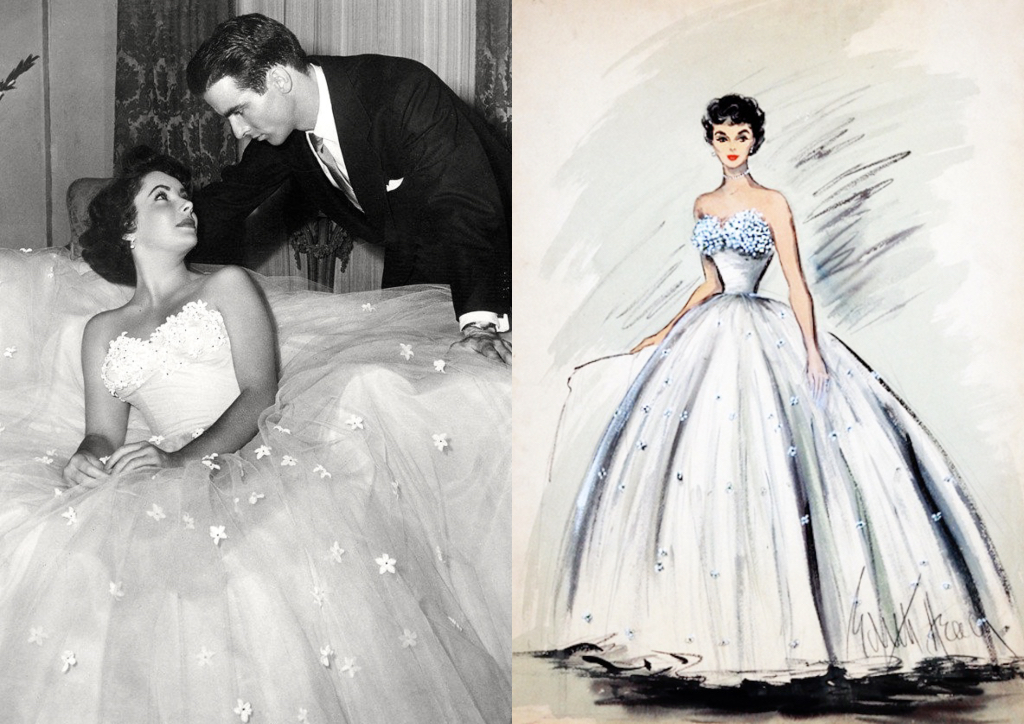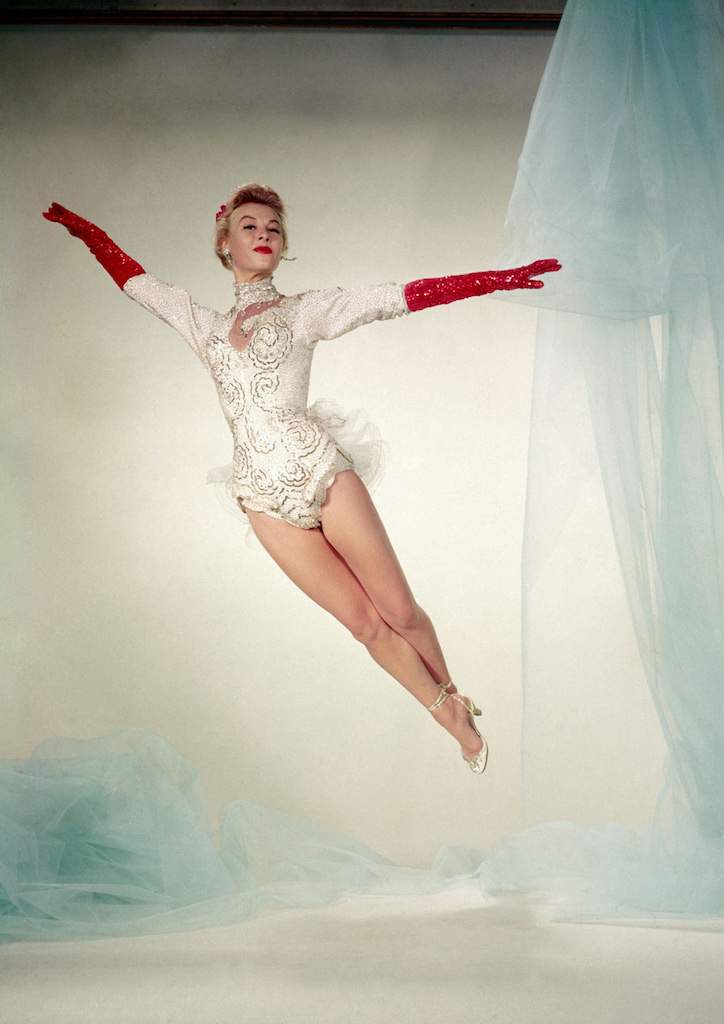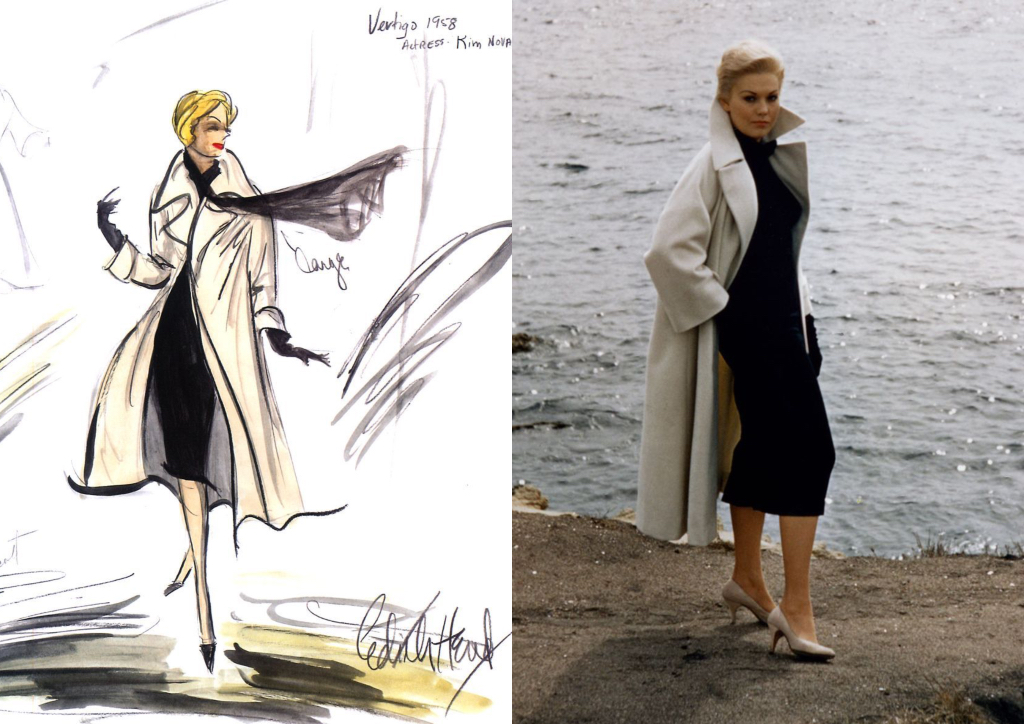Costume design extraordinaire Edith Head had a career in the movies that lasted over five decades. She was responsible for many of the iconic screen outfits of mega stars such as Grace Kelly, Audrey Hepburn and Elizabeth Taylor. The designer was a Hollywood favorite, and her resume showed it. Between 1949 to 1978, Head was nominated for 35 Oscars, winning eight for The Heiress (1949), Samson and Delilah (1949), All About Eve (1950), A Place in the Sun (1951), Roman Holiday (1953), Sabrina (1954), The Facts of Life (1960) and The Sting (1973). “I’m gonna go home a design a dress for it,” she said in the 1954 Academy Awards, where she won for her work in Roman Holiday, her fifth Oscar.

Beginning her career in 1925 during the silent film era, Head found her home at Paramount Pictures, where she was given creative reign over the costuming department. “If it’s a Paramount film, I probably designed it,” she would say. Head became a favorite amongst Hollywood’s most glamorous stars, who loved her easy elegance and modern take on womenswear. A star of epic proportions in her own right, she was Tinseltown’s most esteemed creators, especially during her 1950s heyday.
Till this day, Edith Head is the most honored woman in Hollywood in terms of both Oscar nominations and wins. Her iconic appearance, which consisted of a bob cut and dark sunglasses, has even crossed over to today’s audiences, through Edna Mode from Disney’s The Incredibles, which was modeled after her.
In honor of her career and impeccable design talent, we discuss 12 of Edith Head’s very best film works and how her costumes contributed to the overall quality of the motion picture.

All About Eve (1950)
Fresh from an Oscar win for the previous year’s The Heiress (1949), Head won her second and third Oscar in 1950 for Samson and Delilah (Best Colored Picture Costumes) and All About Eve (Best Black-and-White Picture Costumes). The latter, which also won the year’s Best Picture prize, has remained a classic. It tells the story of Margot Channing (Bette Davis), an aging Broadway star, who suspects that her meekly assistant Eve Harrington (Anne Baxter) is trying to steal her career, her man, and her overall image. Edith Head meticulously crafted outfits that explores many different spectrums of New York high society. From Davis’ impeccably tailored and dark outfits (that fits her fussy diva like a glove) to Anne Baxter’s frumpy assistant coats and ensembles, All About Eve is a masterclass on women’s wear.

Sunset Blvd. (1950)
Despite being nominated for many of her film efforts, Edith Head sadly missed out on a nomination for Billy Wilder’s Sunset Blvd., the dark Hollywood tale of Norma Desmond (played magnificently by Gloria Swanson), an aging silent screen star who is disillusioned on making a big Hollywood comeback. She takes in a broke young screenwriter named Joe Gillis (William Holden) and begins a love affair with him in her house of horrors. Head’s work in Sunset Blvd. is a lot more fun than her previous 1950 film effort. She had to deal with Norma Desmond, a character whose attire very much attributes to her personality. She must be luxe and dramatic, yet a little looney and strange. Most of Norma’s outfits should look like they were worn in the 1920s, a hint of the aging actress’s obsession to remain glamourous and famous. Edith Head knocked it out of the park with her fur coats, metallic dresses, and gorilla fur jackets—everything you would imagine a 1920s movie star buying.
RELATED READS: 10 Lush Movie Musicals in Glorious Technicolor to Chase Away the Rainy Day Blues

A Place in the Sun (1951)
When Elizabeth Taylor wore Edith Head’s white gown with a floral detail on the bodice in A Place in the Sun, fashionistas of the early 1950s went mad. The dress was instantly iconic, and department stores tried to re-create it for selling purposes. Head was beginning to make a name for herself in Hollywood, and with a movie star like Elizabeth Taylor singing her praises, the rest was smooth sailing. She would go on to win another Oscar for the film. Starring Montgomery Clift, Elizabeth Taylor and Shelley Winters, the film told the story of a poor boy named George Eastman, whose work for a rich uncle leads to an introduction into the world of high society. Eager to live this new found life, he begins to court beautiful “It-Girl” Angela Vickers (Taylor). But what shall he do about his meekly wife Alice (Shelley Winters)? The movie is a dark masterpiece starring immaculately dressed beautiful people.

Roman Holiday (1953)
Roman Holiday is Head’s very first collaboration with movie star Audrey Hepburn. In her Hollywood debut, Hepburn played Princess Ann, a royal who escapes from her duties to enjoy a whirlwind holiday in Rome. There she meets a young man (Gregory Peck) who promises to take her around town. What she doesn’t know is that he is actually a journalist looking for an exclusive scoop. The costume designer didn’t have much to work with, since the film spans only two days. However, once you watch it, you will be astonished how Head made all three of Audrey Hepburn’s outfit changes count. She first wears a silk night gown fit for a royal, changes into an everyday look consisting of a white top, poodle skirt, and scarf for her Italian excursion, and finally, we see her in a crispy white royal gown. Three simple looks in a film that ran almost two hours long won Head another Oscar. It comes to show her power in the industry, and her talent and eye as an individual.
RELATED READS: 10 of the Most Expensive Jewelry Pieces in Hollywood Films

Sabrina (1954)
The following year, Head was unstoppable. She had two huge films in 1954, Alfred Hitchcock’s Rear Window and Billy Wilder’s Sabrina. The latter followed the titular character (Audrey Hepburn), a chauffer’s daughter who is madly in love with the boss’ son, David Larrabee (William Holden). Sabrina is then sent off to Paris to learn how to cook for the family. She befriends a wealthy baron, who teaches her how to dress and act like a society girl. Upon returning to New York, she has one mission: to win David’s heart. However, older brother Linus (Humphrey Bogart), cannot let that happen. David is engaged to another woman, and their union would mean millions for the family’s company. Linus takes the Sabrina problem into his own hands, and decides to romance her himself.
This lush romantic comedy is everything you would want in the film—glamour, breathtaking visuals, witty writing, and good acting. Hepburn’s iconic gowns were co-designed by the then-unknown Hubert de Givenchy, who failed to receive Oscar credit for his work. It didn’t stop him from a fruitful career. Under Head’s guidance and Hepburn’s support, Givenchy would go on to have the iconic career we all know of today. Also, Head’s menswear items don’t receive enough credit in Sabrina. In the film she constructs gorgeous clothing for the two male leads, which includes tuxedos, smoking jackets, and sports coats. The white tuxedo Holden wears in the film’s ball scenes is an underrated menswear moment captured on celluloid.
RELATED READS: 11 of the Most Expensive Costumes Made for a Hollywood Film

Rear Window (1954)
Future Princess of Monaco Grace Kelly was a vocal champion of the Hollywood designer. When she received her Best Actress Oscar for The Country Girl, she wore a baby blue Edith Head creation, which is now regarded as one of the very best Oscar dresses of all time. Their collaboration in Rear Window, Alfred Hitchcock’s terrifyingly tense thriller about a crippled photographer investigating a neighborhood murder from his window, is fashion gold. Kelly plays James Stewart’s socialite girlfriend, whose associations with him intertwines her into the horrific train of events. It’s a great film, and also a great excuse to have Kelly rocking out some of the most elegant Edith Head creations. From her black and white cocktail dress to her more casual lime green tailored-suit, the outfits in Rear Window look like they belong on the window displays of Bendel’s in the 1950s.

White Christmas (1954)
White Christmas is considered the non-official sequel to 1942’s Holiday Inn, also an Irving Berlin scored musical costumed by Edith Head. However, more than a decade after the “original”, Head is having much more fun with her designs for the splashy Bing Crosby film. She plays with all sorts of fabrics and colors, that makes the film a feast for the eyes. In one scene, Danny Kaye is dressed in a light grey suit. His shoes are the exactly the same color as his light suit, and it works so well. In another, Rosemary Clooney sensually sings in a black velvet gown that proved to be more of a showstopper than the actual Irving Berlin melody.

To Catch a Thief (1955)
Set in the glittering seaside town of Cannes, To Catch a Thief is Edith Head’s second collaboration with director Alfred Hitchcock and movie star Grace Kelly. It follows the story of an infamous jewel thief named John Robie (Cary Grant) who is tracking down a copycat burglar. The copycats next target is society icon Jessie Stevens (Jessie Royce Landis) and her beautiful daughter Frances (Grace Kelly), who are vacationing at a luxury hotel resort on the French Riviera. Head, who worked with Kelly the year prior, is so familiar with her new muses’ body that she creates breathless fashion moments only improved by the sunny cinematography. Clean lines, off-the shoulder gowns, and bright swimming suits fit her like a glove. However, in a film full of stylish creations, Head’s ultimate showcase happens near the end of the film, during a 15th Century-themed ball. Grace Kelly wears a large golden gown fit for the thrilling finale. It is a feat of engineering.
RELATED READS: Exotic Travel Destinations Inspired by Your Favorite Films

The Ten Commandments (1956)
It was well known around the town of Hollywood that Edith Head did not like working with Cecile B. De Miller, her director for The Ten Commandments. She found him egotistical and rude—an unpleasant person to work with and be around. However, DeMille was just as much a visionary as Head was, and the two heavyweight artists’ collaboration on the biblical Moses flick proved to be quite fruitful. Head was nominated for another Oscar, but this time she shared the honor with Ralph Jester, John Jensen, Dorothy Jeakins and Arnold Friberg. Although Head often worked as a solo act, it was necessary to have a large team on a production of this scale. The film ran almost four hours long and dressed thousands of extras which includes roles of royals, Egyptians nobles, Jewish slaves, and desert people. Although the designers did a spectacular job constructing robes (the most common clothing worn by characters throughout the picture), the artistry is most evident in the royal garments worn by Yul Brynner’s Pharaoh Rameses and Anne Baxter’s Nefretiri. Gold, blue and silver never looked so rich on technicolor.

Funny Face (1957)
After Audrey Hepburn discovered Parisian-based couturier Hubert de Givenchy while filming Sabrina in 1954, she continuously worked with him for the rest of her career. He became a lifelong friend who dressed her both for the screen and in real life. It was only natural that for her next hit Paramount picture, Givenchy get an ungraded screen credit alongside Edith Head as co-costume designer. Film scholars often cite the wardrobe in Funny Face as more of Givenchy, but Head’s impact and influence is still notable throughout the film’s wardrobe. In fact, she was approving all of Givenchy’s designs (as Paramount’s Chief Costume Designer), and creating garments for the movie as well.
Funny Face, the Stanley Donen-directed musical comedy, seems like it was designed purely for “wow” fashion moments. Hepburn plays a young librarian who is discovered by a Richard Avedon-esque fashion photographer played by Fred Astaire. He takes her to Paris to be the cover girl of a Vogue-like magazine. As he shoots her in gorgeous couture in the city’s most picturesque locations, they begin to fall in love. However, his controlling personality may be a bit too much for the young girl. Givenchy and Head create what is probably some of the most beautiful outfits Audrey Hepburn has every put on. Each piece is a work of art in itself, which are all given justice through the lush cinematography of lens man Ray June. Some of the most notable looks: an airy red ball gown with a matching tulle shawl worn down the steps of the Paris Opera house, a white and pink menswear-inspired look used while fishing in the river Seine, and the iconic poodle skirt wedding gown worn in the film’s romantic musical finale.
RELATED READS: Hubert de Givenchy and Audrey Hepburn: A Love Story

Vertigo (1958)
In Alfred Hitchcock’s Vertigo, audiences find themselves in misty San Francisco. James Stewart plays an ex-cop who is hired by an old friend to follow his wife (Kim Novak) and prevent her from her suicidal tendencies. Although Vertigo was originally misunderstood during its initial 1958 release, the film has garnered certified classic status. Today, it still holds up as one of the most mysterious and thrilling experiences ever filmed for the silver screen. Head was tasked to dress the film’s female star, Kim Novak. Although at first glance, the costumes look simple, clean and well-tailored, they are often regarded as some of the most important film costumes ever made. SPOILER ALERT: Kim plays dual characters in the film, and costuming was very important to tell both characters apart. One is a sophisticated yet mysterious city girl, the other a strange but vibrant, reckless wild child.

The Sting (1973)
As Edith Head’s career began to cool down in the 1970s, she still had an Oscar win inside of her. Her victory lap was for George Roy Hill’s Best Picture-winning The Sting, which featured its heavily male led cast in perfectly tailored menswear looks. Paul Newman and Robert Redford reunited for the second time after Butch Cassidy and the Sundance Kid for the film. They played Henry Gondorff and Johnny Hooker, two grifters who combine their skills for a heist of a lifetime. Head had a great opportunity to play with the clothing, as both the male star’s characters were so different in personality. Newman’s Henry was slick and cunning, Redford’s Hooker was rugged and street smart. The result: menswear moments worth remembering. Head’s well-tailored suits, custom hats, dashing tuxedos, and pin-striped garments are some of the best men’s clothing put on film during the 1970s.
RELATED READS: Hollywood’s Long and Complicated History with Queen Elizabeth I





